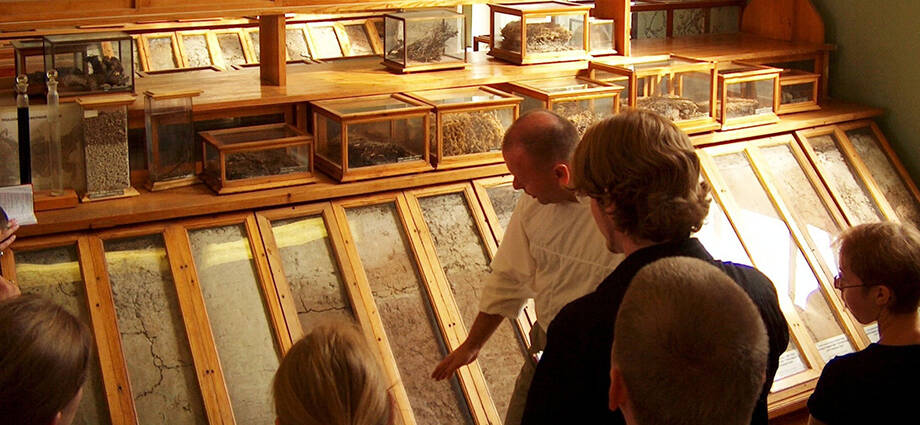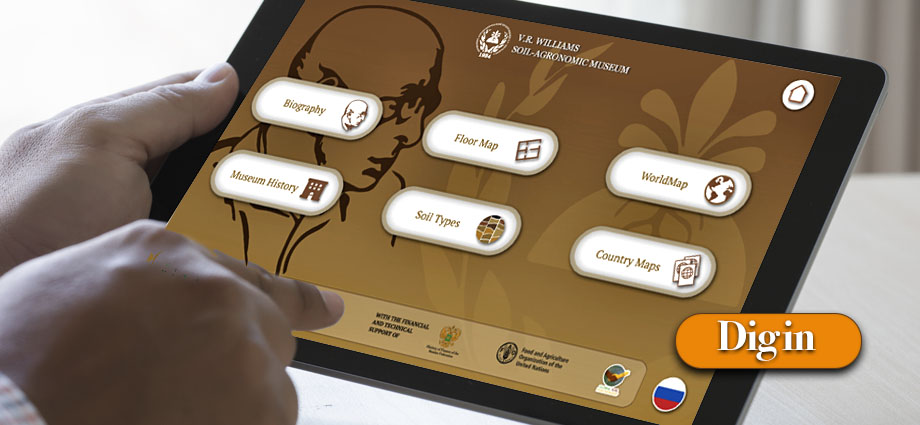Williams Soil-Agronomic Museum

The Williams Soil-Agronomic Museum is one of the largest soil museums of the world.

The Museum exhibits the diversity of soils samples across the globe from the Arctic to tropical regions

The Museum displays a variety of exhibits on agricultural use and preservation of the soil, geneses and anthropogenic soil changes
The Williams Soil-Agronomic Museum, established in 1934 in Moscow, is one of the largest soil museums of the world. The Museum is located at the Moscow Timiryazev Agricultural Academy. The Museum exhibits the diversity of soil samples across the globe from the Arctic to tropical regions, agricultural use and preservation of the soil, geneses and anthropogenic soil changes. It has one of the richest collection of soil monoliths assembled throughout the 20th century, with about 900 monoliths displayed and 2,500 monoliths preserved in the storage room that provide a unique full-scale data and a knowledge base on soils.
The collection of the Museum started in 1888 by V.R. Williams and his students. They collected a great variety of valuable specimens: soil monoliths, samples of genetic horizons, rocks, and herbarium. The museum was opened to the public in 1954. In the same year, the Museum organized its first exhibit through an exposition that summarized not only the research data collected by Timiryazev Academy of Agriculture, but also of many other leading agricultural institutions. It illustrates the evolution of the soil cover of specific regions of Russia, as well as the former USSR. At presents, the main scientific work is conducted in the space of soil science, genesis, classification of soils. From the very beginning the Museum aimed not only to display the great variety of national soils, but also to reflect on the current scientific and applied problems of soil science and agriculture, as well as to promote scientific advancements in agriculture. Workshops have been regularly organized for students and agricultural specialists.
In order to preserve the Museum's incredible heritage and help it move into the digital age, the FAO Global Soil Partnership, together with the FAO Liaison Office in Moscow and thanks to the financial support of the Russian Federation and PhosAgro, supported the Timiryazev Agricultural Academy in the modernization and digitization of the Museum's collections with the aim of making them accessible to a wider national and international audience. In the framework of the Eurasian Soil Partnership and with funding from the Russian Federation, FAO and the Timiryazev Agricultural Academy signed a Letter of Agreement in July 2020 to define modernisation activities. The main achievements are:
On 20 May 2021, the official ceremony launched the modernized Soil Museum. This one-day event was held in presence in the Museum while some speakers and participants joined the ceremony through an online platform (zoom). The ceremony was opened by Ms Elizabeth Bechdol, Deputy Director-General, FAO (online), Prof Vladimir Trukhachev, Rector of the Russian State Agrarian University - Moscow Timiryazev Agricultural Academy, Russian Academy of Sciences, Mr Pavel Snisorenko, Director of International Financial Relations Department of the Ministry of Finance of the Russian Federation, Ms Dilyara Ravilova-Borovik, Deputy Permanent Representative of the Russian Federation to FAO and other Rome-based agencies (online), Mr Andey Guriev, Chairman of the Management Board, CEO of PJSC PhosAgro and moderated by Oleg Kobiakov, Director of the Liaison Office with the Russian Federation. The second segment of the day included a physical tour in the Museum followed by a scientific conference on the role and importance of soil museums worldwide.
Check the photogallery
- The role of Soil Museums in awareness raising and virtual launch of the museum - Mr Ronald VARGAS, Secretary, Global Soil Partnership – Keynote address
- Importance of black soils for global food security and ecosystem services - Ms Natalia RODRIGUEZ EUGENIO, Global Soil Partnership
- Modernization of the William’s Soil Agronomic Museum - Mr Ivan VASENEV, Faculty of Soil Science, Agricultural Chemistry and Ecology of the Russian State Agrarian University - Moscow Timiryazev Agricultural Academy
- The role of Soil Museums in the Implementation Plan of the Eurasian Soil Partnership - Pavel V. KRASILNIKOV, Head of Faculty of Soil Science ad interim, Lomonosov Moscow State University, corresponding member of the Russian Academy of Sciences
- Timiryazev Agricultural Academy Soil Science Department contribution to the collection development of the Williams Soil-Agronomic Museum - Vladimir D.NAUMOV, Head of Department of Soil Science, Geology and Landscape Science of the Russian State Agrarian University - Moscow Timiryazev Agricultural Academy
- The role of the soil monoliths collection of the Williams Soil-Agronomic Museum for a better understanding of the essential diversity of Russian soils - Jetse STOORVOGEL, Soil Geography and Dynamics professor, Wageningen University Research center, Netherlands
- Prospective of the collaboration between European Society of Soil Conservation and Williams Soil Museum for better understanding the modern challenges in environmentally friendly soil management - Carmelo DAZZI, President of the European Society of Soil Conservation, Palermo University, Italy
- Challenges and perspectives of soil museums digitalization - Elena Yu. SUKHACHEVA, Director of the Dokuchaev Central Museum of Soil Science
- Children and soil museums: Discovering the universe beneath our feet - Laura Berta REYES SANCHEZ, President of International Union of Soil Sciences
- Perspectives of use of Williams Museum soil collection as reference points for regional agroecological monitoring - Aleksey N. NALIUKHIN, deputy Head of Pryanishnikov Institute of Agrochemistry
The Williams Soil-Agronomic Museum goes digital! Dig in for a unique virtual experience

This multimedia application will allow you to explore the fascinating world of soil science from the comfort of your own home. No matter where you are in the world and whether you're a student, a soil scientist, or simply a curious individual, soil science is right at your fingertips.
Start exploring now the country maps, the monoliths, the museum history and much more!
News and events

LAUNCH EVENT

